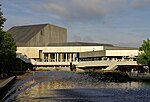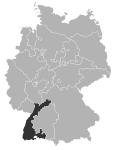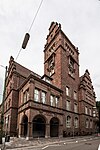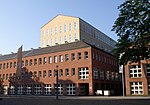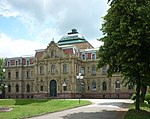Kongresszentrum Karlsruhe
Buildings and structures in KarlsruheConvention centres in Germany

Tbe Kongresszentrum Karlsruhe (Karlsruhe Congress Centre), located in Karlsruhe, Baden-Württemberg, Germany is the largest inner-city congress centre in Germany, operated by the Karlsruher Messe- und Kongress GmbH. It is located within walking distance of the main railway station and comprises about 20,000 m2 (220,000 sq ft) of exhibition space in four halls arranged around the 10,000 m2 (110,000 sq ft) Festplatz.The congress centre consists of the Stadthalle, the Konzerthaus, the Schwarzwaldhalle and the Gartenhalle. The centrepiece of the convention centre, the Stadthalle, has been under renovation and closed since mid-2017.
Excerpt from the Wikipedia article Kongresszentrum Karlsruhe (License: CC BY-SA 3.0, Authors, Images).Kongresszentrum Karlsruhe
Festplatz, Karlsruhe Südweststadt
Geographical coordinates (GPS) Address Nearby Places Show on map
Geographical coordinates (GPS)
| Latitude | Longitude |
|---|---|
| N 49.0027 ° | E 8.4013 ° |
Address
Stadthalle
Festplatz 4
76137 Karlsruhe, Südweststadt
Baden-Württemberg, Germany
Open on Google Maps




